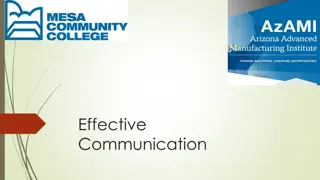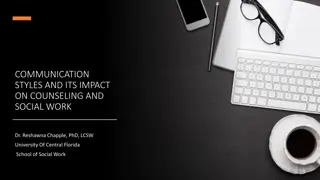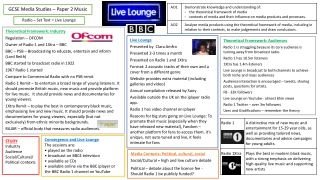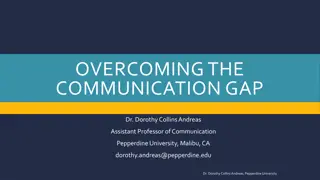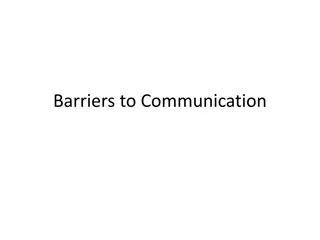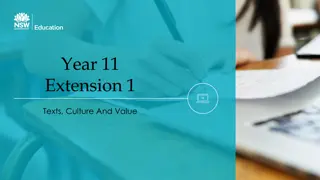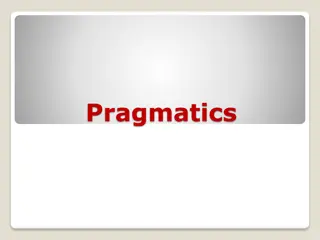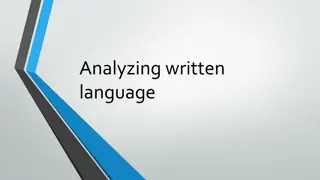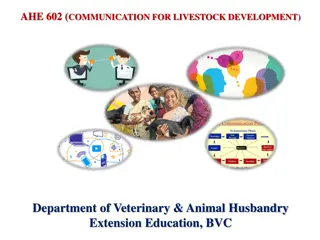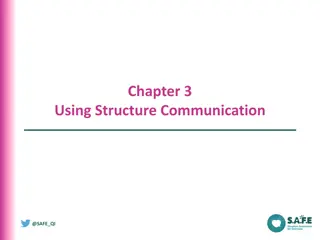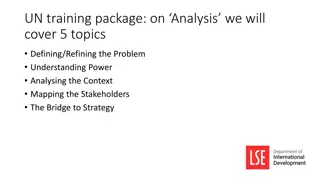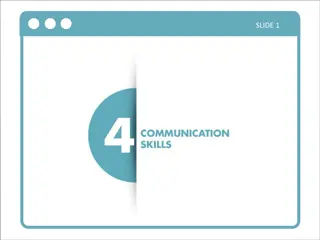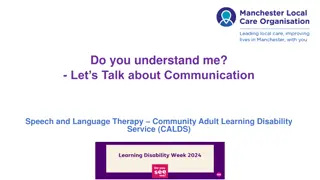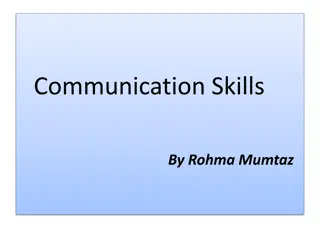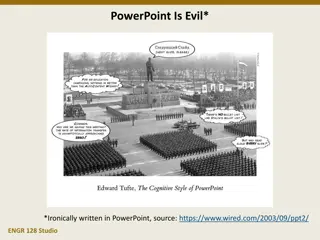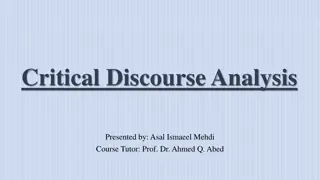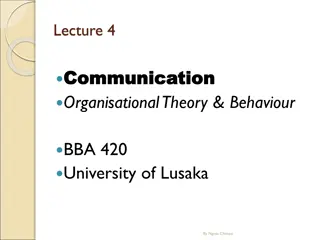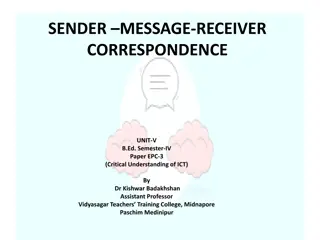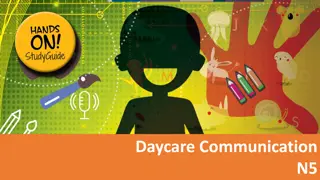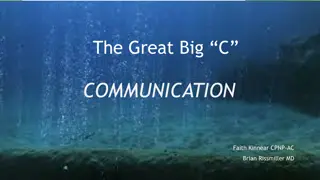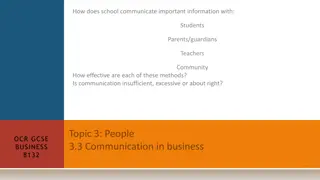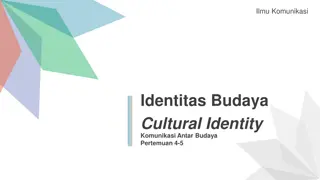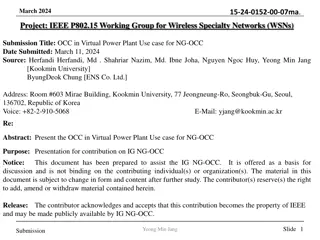Exploring the Power of Effective Communication in Different Contexts
Delve into the importance of effective communication in various settings such as family, work, and community. Understand the role of communication, identify barriers, and learn strategies to overcome them successfully. Discover how to create SMART goals for improving family dynamics through enhanced communication skills.
Download Presentation

Please find below an Image/Link to download the presentation.
The content on the website is provided AS IS for your information and personal use only. It may not be sold, licensed, or shared on other websites without obtaining consent from the author. Download presentation by click this link. If you encounter any issues during the download, it is possible that the publisher has removed the file from their server.
E N D
Presentation Transcript
Discuss: Was this task easy or difficult? Why?
Discuss: What role does communication play in our lives?
Where Were Going: The member will be able to identify and demonstrate characteristics of effective communication in family, work, and community settings. The member will be able to identify communication barriers and apply strategies to overcome them successfully. The member will be able to devise a project to improve his or her family based on a SMART goal for the Family Ties Power of One unit.
How Well Get There: What is effective communication and what does it look like? Barriers to effective communication Strategies to overcome those barriers Analyzing communication in different contexts Power of One: Family Ties
Most people do not listen with the intent to understand; they listen with the intent to reply. -Stephen R. Covey
Communication: The two-way process of reaching mutual understanding, in which participants not only exchange information, news, ideas and feelings but also create and share meaning. Source: http://www.businessdictionary.com/definition/communication.html
Think: What is communication in your own words?
Four Forms of Communication: Verbal Nonverbal Written Face-to-face, TV, radio, telephone, other media Facial expressions, body language, dress, scent Pen and paper, e-mail, social media, magazines, books, text messaging, the internet Visual Maps, logos, charts, graphs Source: https://www.skillsyouneed.com/ips/what-is-communication.html
Three Parts of Communication: Sender Encodes a message verbally and nonverbally or in writing or graphics Message What is actually communicated; May be effective or ineffective Receiver(s) Responsible for decoding the sender s message; May interpret the message differently than the sender intended Source: https://www.skillsyouneed.com/ips/what-is-communication.html
The Seven Cs of Communication: Clear Make your objective clear by avoiding complex phrases and words Concise Concrete Correct Keep it to the point to avoid confusion Use support for the message to validate what is said Speak truthfully and use correct grammar Source: https://expertprogrammanagement.com/2018/04/7-cs-communication/
The Seven Cs of Communication: Coherent Complete Courteous Messages should make sense and flow All necessary information should be communicated Consider the audience and deliver the message with tact Source: https://expertprogrammanagement.com/2018/04/7-cs-communication/
Barriers to Effective Communication
Barriers to Effective Communication Lack of attention/interest Distractions Differences in perception and viewpoint Expectations and prejudices Use of jargon Speech difficulties, language differences Technological barriers (Unable to see nonverbal communication)
Overcoming Barriers to Effective Communication
Overcoming Barriers to Effective Communication 1. Practice Active Listening Maintain eye contact Paraphrase a message to the sender to ensure understanding Ask questions Be present 2. Change your mindset Most people do not listen with the intent to understand; they listen with the intent to reply. -Stephen R. Covey Stop thinking I must defend my position, I don t have time to listen to everything you say, I need an entrance into the conversation, I know what you are going to say, and I already know what you should do.
Overcoming Barriers to Effective Communication 3. Consider the other person s perspective How would the other person perceive your words, nonverbal communication, or text or graphic? What is your audience s background? 4. Use I messages I messages allow a sender to express strong emotions without attacking the receiver. You constantly interrupt me! vs. It makes me upset when I am not allowed to finish my sentence.
Brainstorming Matrix: What does communication look like in these contexts? Family Community Career
Context What forms of communication happen in this context? Give specific examples. What are potential barriers to effective communication in this context? Give specific examples. How can these barriers be overcome? Give specific examples.
Discuss: Why is communication critical in a family and how does this impact communication in other areas of life?
Answers: Needed for healthy relationships, problem solving, and growth. Healthy families are proven to support productive employees. Good communication at home teaches good communication in the workplace.
Family Ties Family Ties is the second unit in the FCCLA Power of One national program. This unit focuses on strengthening one s family and home life. The family is the basic unit of society. By making stronger families, we have stronger communities.
Executing Your Family Ties Project Brainstorm areas/aspects of your family you would like to improve. Decide which project area is your top priority. Make a list of ways you would like to improve yourself in your chosen project area. Use the FCCLA Planning Process to set a SMART goal to achieve and plan a project to meet your goal.
In Summary Effective verbal and nonverbal communication is critical in school, work, communities, families, and electronic contexts. Numerous barriers to communication exist, but strategies can be used to overcome them. Family Ties is the second unit of Power of One that focuses on strengthening families and homes. Your Family Ties project does not have to relate directly to communication, but effective communication must be used in any effort to strengthen a family.
Which topics interest you? Caring for your own space and clothes Reducing arguments with family members Caring for family pet Improving communication with family members Making time for family Improving family relationships Keeping up with household responsibilities Spending time with parent, stepparent, grandparent, or other relative Helping with family meal time Becoming a more responsible family member Organizing fun family activities Preparing a family tree or genealogy journal Understanding and working toward family goals Accepting family members' viewpoints Dealing with serious family challenges (such as illness, physical handicaps, divorce, death, suicide, alcoholism, abuse) Stopping negative talk
What goal do you want to achieve within a topic? Babysit younger siblings one night a week so parents can have a night out Keep my possessions neat and organized Organize a family community picnic Organize and maintain my clothes and closet Make a chart to track my household jobs Feed, exercise, and clean up after the family pet Plan and carry out a schedule of family car care (washing and/or maintenance) Set up a "fun at home" night for all family members Collect favorite recipes from grandparents, aunts, uncles, cousins, and create a family cookbook Organize and conduct family meetings Learn about a family member s career Participate in FCCLA @ the Table Interview a parent, grandparent, or other relative about his or her youth Plan and carry out family devotions
What goal do you want to achieve within a topic? Volunteer to take care of an additional household responsibility Interview your grandparents on what a particular aspect of daily life was like when they were your age (favorite foods and their cost, entertainment, important world affairs, etc.) and compare it with your own experiences Set up and lead a family council meeting Prepare a family tree or genealogy journal Interview older relatives and write a family history Create a scrapbook of family photos Create a family website to share family news with distant relatives Make a family tree Call or write a distant relative on a regular basis Create a family time capsule Practice conflict-resolution techniques in the family Say only positive things about my family Create a fun activity to do with a brother or sister Help family members (and self) deal with a family challenge Schedule an hour a day to spend talking with family members Other
Use your Family Ties project sheet to begin planning your project. Remember, set a SMART goal.




